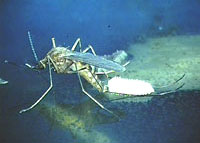As summer finally rolls in, most of us are eager to shed our layers and splash in the surf or hike through the woods. Along the way, we might slap on some SPF 30 sunscreen to ward off skin cancer and hose down our arms and necks with skeeter repellent. But rather than go wild with DEET and just any old high-SPF sunscreen, it’s best to consider some potential health and environmental hazards first. Here follows a look at some of the more problematic products and their less-toxic alternatives.
Bug Repellent

The mosquito cost.
Photo: Centers for Disease Control.
Insect repellent is likely to be a hot item this year, with fears of the mosquito-borne West Nile virus running high. (Paul Epstein, associate director of the Harvard Medical School Center for Health and the Global Environment, warns that the virus will likely be as devastating this year as it was in 2002, when it killed 284 people in North America.) But before you reach for the bug spray, take a second look.
Most conventional insect repellents contain DEET (also listed on labels as N, N-Diethyl-m-toluamide or N, N-Diethyl-3-Methyl benzamide). DEET is highly effective at repelling mosquitoes, but is also an eye irritant and can cause blisters and rashes on some users. More rarely, DEET has been associated with lethargy, confusion, disorientation, and mood swings. These concerns have resulted in Canada’s banning DEET in concentrations higher than 30 percent. In any case, it’s wise to minimize exposure by selecting a product containing 10 percent or less, such as Off! Skintastic Family Formula or Cutter All Family. Never use DEET on children under two years of age, and do not apply bug repellent containing DEET to hands or faces, or to cut or sunburned skin.
DEET is also a persistent environmental contaminant that breaks down slowly in soil. A recent U.S. Geological Survey report on water contaminants listed DEET as one of the compounds most frequently found in the nation’s streams. The U.S. EPA regards DEET as “slightly toxic” to birds, fish, and aquatic invertebrates — which, given its frequent appearance in waterways, should give one pause.
For simple, non-toxic bug-bite prevention, wear long sleeves and long pants in light colors. (Mosquitoes may be attracted to dark colors.) Stay indoors from dusk till dawn, when the bugs are worst. Since mosquitoes can breed even in tiny pools of stagnant water, inspect your property for potential larvae homes, such as saucers under plants, spare tires, clogged gutters, birdbaths, and rain puddles. Make sure window screens are hole-free. To avoid ticks, stick to the center of paths and trails and try not to brush against grasses.

Among DEET-free insect repellents, Bite Blocker was rated by Consumer Reports as effective against mosquitoes for one to four hours; its active ingredient is soybean oil. Another plant-based option is Green Ban, which also claims to repel ticks. Insect repellents made of botanical oils may offer limited protection against biting bugs. While not as effective as DEET, frequent reapplication can help. The all-natural Buzz Away, for example, contains 5 percent citronella, plus lemongrass, peppermint, and cedarwood oils; it comes in spray or foil-wrapped towelette form, handy for travel. Buzz Away and other DEET-free insect repellents can be found at natural-food stores. Be sure to test them on a small area of skin first, as some people are allergic to citrus or other aromatic plant oils.
Sunscreen
Skin cancer from exposure to sunlight is a serious health risk, but fortunately the American Cancer Society says that many cancer cases can be prevented by taking precautions such as avoiding the sun and wearing sunscreen. The latter step, however, can pose problems of its own.
Ironically, some sunblocks contain suspected carcinogens, including diethanolamine and related ingredients (DEA, TEA), padimate-o, and titanium dioxide. Other ingredients are suspected endocrine disrupters: benzophenone (oxybenzone), homosalate, octyl-methoxycinnamate (octinoxate), and the parabens (methyl-, ethyl-, butyl-, propyl-). Moreover, sunscreens can contain chemicals associated with skin irritation and rashes, including avobenzone (parsol 1789), benzophenone, octyl-methoxycinnamate, and PABA (para-aminobenzoic acid).
Not only are these chemicals potentially bad for you, they’re bad for the environment. Diethanolamine has been found in waterways around the country, posing a threat to animals and humans. According to the National Toxicology Program, benzophenone has been found in surface water and groundwater, as well as soil and air, and may affect the liver and bone marrow of animals ingesting large amounts of the water. This and other endocrine disruptors in sunblocks can also enter the water system when we swim or bathe, and from there can wind up in fish, amphibians, and marine wildlife, posing a threat to the animals’ reproductive cycles.

A bright idea.
Photo: Centers for Disease Control and Prevention.
Some solutions: For that famous Southern California lifeguard look, try bright white zinc oxide, which does not irritate skin and has not been linked with any environmental or health problems. For a benzophenone-free product, try California Baby SPF 30+ Sunscreen or Aubrey Organics Titania Sunblock SPF 25 (but it does contain PABA).
Whenever possible, wear sunglasses with UV protection, a wide-brimmed hat, tightly woven fabrics, long-sleeved shirts, and long pants or airy cover-ups such as caftans. Carry a parasol for that romantic Age of Innocence look. Severe sunburns in childhood may greatly increase risk of melanoma later in life, so children should be particularly well-protected from the sun. Keep infants out of the sun entirely, minimize children’s sun exposure between the hours of 10 a.m. and 3 p.m., put up big umbrellas at the beach or in the garden, and avoid using sunscreens on children younger than six months, unless there is no other way to protect them from the sun.

